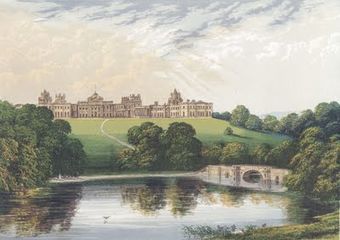Annotation:Blenheim Castle: Difference between revisions
No edit summary |
No edit summary |
||
| (4 intermediate revisions by 2 users not shown) | |||
| Line 1: | Line 1: | ||
---------- | |||
---- | {{TuneAnnotation | ||
|f_tune_annotation_title= https://tunearch.org/wiki/Annotation:Blenheim_Castle > | |||
'''BLENHEIM CASTLE'''. AKA - "Bleinheim Castle." English, Country Dance (3/4 time). D Dorian. Standard tuning (fiddle). AAB. The tune appears in the first two editions of London publisher John Young's '''Second Volume of the Dancing Master''' as "Bleinheim Castle", and in the latter two editions (of 1718 and 1728) as "Blenheim Castle." The melody was also published by rivals Walsh and Hare in their '''The Second Book of the Compleat Country Dancing-Master''' in 1719. | |f_annotation='''BLENHEIM CASTLE'''. AKA - "Bleinheim Castle." English, Country Dance (3/4 time). D Dorian. Standard tuning (fiddle). AAB. The tune appears in the first two editions of London publisher John Young's '''Second Volume of the Dancing Master''' as "Bleinheim Castle", and in the latter two editions (of 1718 and 1728) as "Blenheim Castle." The melody was also published by rivals Walsh and Hare in their '''The Second Book of the Compleat Country Dancing-Master''' in 1719. | ||
<br> | <br> | ||
<br> | <br> | ||
[[File:blenheim.jpg| | [[File:blenheim.jpg|340px|thumb|left|Blenheim Palace]] | ||
At the time of Young's 1st edition (1710) the Blenheim Castle [http://en.wikipedia.org/wiki/Blenheim_Palace] (House or Palace), a grand country house, had been under construction for five years, as the reward for the successes of John Churchill in his victory over the French and Bavarians in the Battle of Blenheim (1704). Built in the English Baroque style, it was not to be finished until 1722. Churchill, in the meantime, continued to be victorious in military battles on the Continent, was raised Duke of Marlborough, and endured a period of exile before returning to the residence. It was the seat of the Dukes of Marlborough for 300 years. | At the time of Young's 1st edition (1710) the Blenheim Castle [http://en.wikipedia.org/wiki/Blenheim_Palace] (House or Palace), a grand country house, had been under construction for five years, as the reward for the successes of John Churchill in his victory over the French and Bavarians in the Battle of Blenheim (1704). Built in the English Baroque style, it was not to be finished until 1722. Churchill, in the meantime, continued to be victorious in military battles on the Continent, was raised Duke of Marlborough, and endured a period of exile before returning to the residence. It was the seat of the Dukes of Marlborough for 300 years. | ||
|f_source_for_notated_version= | |||
' | |f_printed_sources=Offord ('''John of the Green: Ye Cheshire Way'''), 1985; p. 95. Young ('''Second Volume of the Dancing Master, 1st edition'''), 1710; p. 70. | ||
|f_recorded_sources= | |||
|f_see_also_listing= | |||
}} | |||
------------- | |||
'' | |||
---- | |||
Latest revision as of 19:04, 29 April 2022
X:1 T:Blenheim Castle M:3/4 L:1/8 R:Country Dance B:Young - Second Volume of the Dancing Master (1710, p. 70) K:Ddor D<E|F2A2- A/B/^c|d2D2-D/E/F|E2G2-G/A/B|c2C2-C/D/E| F2A2-A/B/^c|d>^c de- e/d/e|f>e fg- g/>f/e|f2 d-d/:|| d<e|f>e fg- g/fg|a2c2- c/d/e|f>e fg- g/f/g|a2 A2- A/B/C| B2d2- d/e/f|g2 G2- G/A/B|c>B cd- d/e/f|e2 c2-c/F/A| _B>c BA- A/B/c|B>c d^c- d/B/A|d>e fe- e/f/g|f2d2- d/d/A| _Bd g^c-ce|a>g fe- e/f/g|f2d2=d/||
BLENHEIM CASTLE. AKA - "Bleinheim Castle." English, Country Dance (3/4 time). D Dorian. Standard tuning (fiddle). AAB. The tune appears in the first two editions of London publisher John Young's Second Volume of the Dancing Master as "Bleinheim Castle", and in the latter two editions (of 1718 and 1728) as "Blenheim Castle." The melody was also published by rivals Walsh and Hare in their The Second Book of the Compleat Country Dancing-Master in 1719.

At the time of Young's 1st edition (1710) the Blenheim Castle [1] (House or Palace), a grand country house, had been under construction for five years, as the reward for the successes of John Churchill in his victory over the French and Bavarians in the Battle of Blenheim (1704). Built in the English Baroque style, it was not to be finished until 1722. Churchill, in the meantime, continued to be victorious in military battles on the Continent, was raised Duke of Marlborough, and endured a period of exile before returning to the residence. It was the seat of the Dukes of Marlborough for 300 years.

